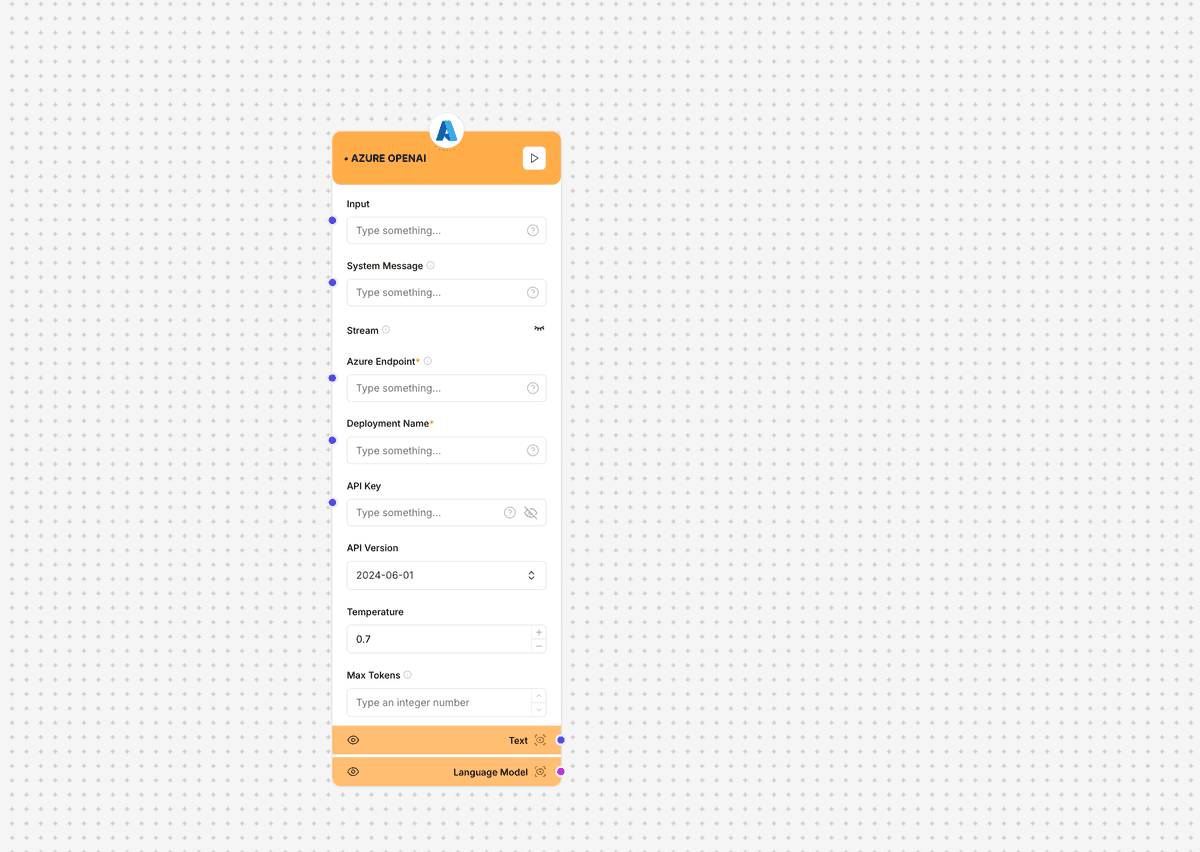Azure OpenAI Models
A drag-and-drop component for integrating Azure OpenAI services into your workflow. Configure deployment settings and model parameters for enterprise-grade AI capabilities.

Azure OpenAI component interface and configuration
Azure Setup Required: This component requires a valid Azure OpenAI service setup. Ensure you have created the appropriate deployment and have the necessary permissions before using this component in production.
Component Inputs
- Input: Text input for the model
Example: "Explain quantum computing to a high school student."
- System Message: System prompt to guide model behavior
Example: "You are an educational assistant who explains complex topics using simple analogies."
- Stream: Toggle for streaming responses
Example: true (for real-time token streaming) or false (for complete response)
- Azure Endpoint: Your Azure OpenAI service endpoint
Example: "https://your-resource-name.openai.azure.com/"
- Deployment Name: Name of your model deployment
Example: "gpt-4", "gpt-35-turbo"
- API Key: Your Azure OpenAI API key
Example: "cdd78d98abcdef12345678910abcdef"
- API Version: Azure OpenAI API version
Example: "2024-06-01"
Component Outputs
- Text: Generated text output
Example: "Quantum computing is like a special kind of calculator that uses the weird rules of very tiny particles..."
- Language Model: Model information and metadata
Example: deployment: gpt-4, usage: {prompt_tokens: 35, completion_tokens: 120, total_tokens: 155}
Model Parameters
Temperature
Controls randomness in the generated text - higher values create more diverse outputs
Default: 0.7
Range: 0.0 to 2.0
Recommendation: Lower (0.0-0.3) for factual tasks, Higher (0.7-1.0) for creative applicationsMax Tokens
Maximum number of tokens to generate in the response
Default: Varies by model
Range: 1 to model maximum (e.g., 4096 for GPT-4)
Recommendation: Set according to expected response length and keep buffer for longer responsesImplementation Example
// Basic configuration
const azureOpenAI = {
azureEndpoint: "https://your-resource-name.openai.azure.com/",
deploymentName: "gpt-4",
apiKey: process.env.AZURE_OPENAI_API_KEY,
apiVersion: "2024-06-01",
systemMessage: "You are a helpful assistant."
};
// Advanced configuration
const advancedAzureOpenAI = {
azureEndpoint: "https://your-resource-name.openai.azure.com/",
deploymentName: "gpt-35-turbo",
apiKey: process.env.AZURE_OPENAI_API_KEY,
apiVersion: "2024-06-01",
maxTokens: 2000,
temperature: 0.5,
stream: true,
frequencyPenalty: 0.5,
presencePenalty: 0.0,
topP: 0.95
};
// Usage example
async function generateResponse(input) {
const response = await azureOpenAIComponent.generate({
input: input,
systemMessage: "You are an expert in finance.",
temperature: 0.3
});
return response.text;
}Use Cases
- Enterprise Applications: Build AI solutions with Microsoft's compliance and security standards
- Regulated Industries: Deploy AI in healthcare, finance, and government with proper data governance
- Content Creation: Generate marketing copy, documentation, and reports with enterprise controls
- Conversational Agents: Create enterprise-ready chatbots and virtual assistants
- Data Processing: Extract insights and summaries from documents with proper data residency
Best Practices
- Secure API keys using Azure Key Vault or environment variables
- Monitor usage and costs through Azure portal
- Implement proper error handling for API failures
- Choose appropriate deployment regions for data residency requirements
- Regularly update to the latest API versions for new features